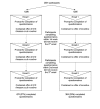Impact and costs of incentives to reduce attrition in online trials: two randomized controlled trials
- PMID: 21371988
- PMCID: PMC3221348
- DOI: 10.2196/jmir.1523
Impact and costs of incentives to reduce attrition in online trials: two randomized controlled trials
Abstract
Background: Attrition from follow-up is a major methodological challenge in randomized trials. Incentives are known to improve response rates in cross-sectional postal and online surveys, yet few studies have investigated whether they can reduce attrition from follow-up in online trials, which are particularly vulnerable to low follow-up rates.
Objectives: Our objective was to determine the impact of incentives on follow-up rates in an online trial.
Methods: Two randomized controlled trials were embedded in a large online trial of a Web-based intervention to reduce alcohol consumption (the Down Your Drink randomized controlled trial, DYD-RCT). Participants were those in the DYD pilot trial eligible for 3-month follow-up (study 1) and those eligible for 12-month follow-up in the DYD main trial (study 2). Participants in both studies were randomly allocated to receive an offer of an incentive or to receive no offer of an incentive. In study 1, participants in the incentive arm were randomly offered a £5 Amazon.co.uk gift voucher, a £5 charity donation to Cancer Research UK, or entry in a prize draw for £250. In study 2, participants in the incentive arm were offered a £10 Amazon.co.uk gift voucher. The primary outcome was the proportion of participants who completed follow-up questionnaires in the incentive arm(s) compared with the no incentive arm.
Results: In study 1 (n = 1226), there was no significant difference in response rates between those participants offered an incentive (175/615, 29%) and those with no offer (162/611, 27%) (difference = 2%, 95% confidence interval [CI] -3% to 7%). There was no significant difference in response rates among the three different incentives offered. In study 2 (n = 2591), response rates were 9% higher in the group offered an incentive (476/1296, 37%) than in the group not offered an incentive (364/1295, 28%) (difference = 9%, 95% CI 5% to 12%, P < .001). The incremental cost per extra successful follow-up in the incentive arm was £110 in study 1 and £52 in study 2.
Conclusion: Whereas an offer of a £10 Amazon.co.uk gift voucher can increase follow-up rates in online trials, an offer of a lower incentive may not. The marginal costs involved require careful consideration.
Trial registration: ISRCTN31070347; http://www.controlled-trials.com/ISRCTN31070347 (Archived by WebCite at http://www.webcitation.org/5wgr5pl3s).
Conflict of interest statement
None declared
Figures
References
-
- CONSORT Transparent Reporting of Trials. 2010. [2011-01-09]. CONSORT 2010 statement http://www.consort-statement.org/
-
- Medical Research Council . Medical Research Council Clinical Trial Series. London, UK: Medical Research Council; 1998. [2011-01-09]. 5vc87ZA7l MRC guidelines for good clinical practice in clinical trials http://science.cancerresearchuk.org/prod_consump/groups/cr_common/@fre/@....
-
- Eysenbach G. The law of attrition. J Med Internet Res. 2005;7(1):e11. doi: 10.2196/jmir.7.1.e11. http://www.jmir.org/2005/1/e11/v7e11 - DOI - PMC - PubMed
Publication types
MeSH terms
Associated data
Grants and funding
LinkOut - more resources
Full Text Sources
Medical




